Must blood sugar be kept within normal limits?
This is a very good question! Why? Because as long as there is a little medical knowledge of adults, 100% of them know that blood glucose must be controlled within the normal range; however, why blood glucose must be controlled within the normal range, it is estimated that the people who know, perhaps less than 10%.
So, it's still worth priming the pump with the gang so that we can get to the root of what blood sugar control means in life.
Below, I'll start with Where Does Blood Sugar Come From? Where it goes! How is blood sugar regulated? What will happen to the body if blood sugar is out of control? These 4 aspects will be exchanged and discussed with you, just for reference.

Where does our body's blood sugar come from?
By blood sugar, we mean the glucose in our body's blood, which comes from the following sources3 pathways:
The main source is food:Sugar in our three meals a day is the main source of blood sugar; however, the sugar in food is mainly starch, which must be turned into glucose by enzymes before it can be absorbed by our bodies.
The next source is glycogen:One of the main things that happens is that the liver breaks down glycogen into glucose, which is what we have when we are fasting, i.e. fasting blood sugar.
The final source is xenobiotic sugar:That is, glucose produced by substances that are not sugar, such as glycerol, lactic acid, and sugar-producing amino acids, through gluconeogenesis, and when we are chronically starved, the sugar in our bloodstream relies primarily on these xenobiotic sugar sources.
So, our body's blood sugar comes from 3 pathways: food, glycogen, and xenobiotic sugar.

Where does our body's blood sugar go?
To summarize, and boil it down, there are 4 ways out of our body's blood sugar:
1. Turned into energy for the body's needs:This is the main outlet for blood sugar and its physiological value, i.e., in the tissues, through oxidative breakdown, into energy for the body's use.
2. Turns into glycogen and stabilizes blood sugar:This is a way of storing excess blood sugar in the body. Mainly in the cells of the liver, muscles and other tissues, glucose is turned back into glycogen, both storing glucose and maintaining stable blood sugar;
3. turn into non-sugar to sustain life:Our body needs many active substances to participate in life activities, such as ribose, aminosugar, glucuronic acid and so on, and even fats, non-essential amino acids and so on, all without the participation of glucose.
4. Urine excretion, abnormal urinary sugar:The last way out, i.e., urine sugar, is not a "way of life" but a "way of death".
This is because, when the concentration of blood glucose is so high that it exceeds the ability of the renal tubules to reabsorb it, it has to be excreted in the urine, which is called diabetes.
Sugar going through the urine is not a good thing, there must be something wrong with the body, and common ones are diabetes, Cushing's syndrome, hyperthyroidism, and even pheochromocytoma.
To summarize, there are 4 ways out of blood sugar, the first 3 of which are "life", while the last one, i.e. diabetes, is "death".
The 3 major organs that regulate our body's blood sugar
So, let's talk a little bit more about the 3 main organs that control our body's blood sugar.
Blood sugar in a healthy person's body, its way in and out is subject to precise regulation, so that there will be a relative stability of blood glucose concentration, and in our body, the regulation of blood glucose of the 3 organs are: the nervous system, hormones and tissues and organs, which work in concert to regulate the stability of blood glucose.
1. Indirect regulation by the nervous system:Indirect stabilization of blood glucose is achieved mainly by regulating the secretion of related hormones.
2. Direct regulation by hormones in the body:Mainly through insulin, glucagon, adrenaline, glucocorticoids, growth hormone and thyroid hormones, etc., which synergize and antagonize each other to maintain a constant blood glucose concentration.
3. Self-regulation of tissues and organs:The most important thing is the liver. When the blood glucose concentration is too high, liver cells transfer the high concentration of glucose into liver cells and synthesize liver glycogen to be preserved; when the blood glucose concentration is low, liver cells turn glycogen into glucose and release it into the blood.
So, the 2-hour glucose load test, also known as the glucose tolerance test, used in the diagnostic criteria for diabetes is to find out how well our body's liver cells, can regulate blood glucose concentration.
So, the 3 main organs that regulate our body's blood sugar are: the nervous system, the body's hormones and the tissues and organs.

What happens to our bodies if our blood sugar gets out of control?
Through the above analysis, we understand the sources and destinations of blood sugar, as well as the 3 major organs that regulate blood sugar. Then, the next step, which is also the core and key of this article: if blood sugar is out of control, what will happen to our body?
1. What will happen to our bodies if our blood sugar rises?
If our body's blood sugar is elevated, then it may increase the amount of urinary sugar, which, as a direct consequence, can lead to osmotic diuresis, thepolyuria;
Secondly, if polyuria, it will lead to a large amount of water loss, and the osmotic pressure of the blood will rise accordingly, that is to say, the formation of hypertonicity; and hypertonicity can stimulate the thirst center of the hypothalamus, resulting in thirst, that is to say, thedrink more;
Finally, if blood sugar is elevated and there is a relative or absolute lack of insulin, then glucose cannot be utilized in the body so that the body has to go and over-consume its own stores of protein and fat to replenish it, and the body, in order to balance theeat more; but even though he eats a lot, he still weighsminimize。
These are the famous "three more and one less" symptoms of diabetes.
And once you have diabetes, it's no joke, the course of the disease for a long time, will trigger multi-system damage, such as eyes, kidneys, nerves, heart, blood vessels and other tissues and organs, will occur chronic lesions, functional decline and failure, until death.
2. What happens to our bodies if our blood sugar is too low?
Above we talked about how if blood sugar is elevated, the pathological consequence is diabetes; so what happens to our bodies if blood sugar is too low?
If what is happening is neonatal hypoglycemia:Then, there will be pallor, shortness of breath, fogginess, easy crying, intermittent twitching, and feeding difficulties.
If what is happening is hypoglycemia in children:Symptoms such as palpitations, sweating, tremors, weakness, heart palpitations, and even grand mal seizures can manifest.
If what is happening is hypoglycemia in pregnant women:Symptoms such as dizziness, palpitations, weakness, hand tremors and sweating can occur.
If hypoglycemia occurs in older adults:Symptoms such as profuse sweating, palpitations, nausea, and pallor will occur, as well as personality changes, insomnia, and dreamy phenomena, and may even induce myocardial infarction and cerebral infarction.
To summarize: the body's blood sugar must be controlled in the normal range; otherwise, once the blood sugar is out of control, our body will be unimaginable.
Do you agree with me?
Daily update on health hotspots, medical pain points; if what I say, is exactly what you think, then please like, retweet, follow Zhu Xiaojun said health!
Special note: All recommended medications in the comments section should be tried with caution and never purchased with a call!
The answer to this question can also lead to different conclusions due to different understandings and different situations.
For those who have diabetes and those who do not have diabetes, the "normal range" of blood glucose control is not the same, and for older diabetic patients, according to the different conditions of the body, the requirements of blood glucose control are also different from those of young diabetic patients, but the general principle will not change, that is, to ensure that the health benefits of the However, the general principle remains the same, that is, under the premise of ensuring health benefits, try to control the blood sugar level to reach the standard, this "normal range" can be analyzed and formulated according to different situations.
For those who do not have diabetes, the normal range of fasting blood glucose is 3.9~6.1mmol/L (the following units are the same), and the two-hour postprandial blood glucose or random blood glucose should not be more than 7.8, of course, if there is no abnormality of blood glucose metabolism, this blood glucose level does not need to be deliberately controlled, and it should be in the normal range, but good and healthy habits, reasonable diet, maintain good weight, strengthen exercise, etc. can help to reduce the burden of blood glucose metabolism, and reduce the occurrence of abnormalities of blood glucose metabolism in the body. However, good and healthy living habits, reasonable diet, maintaining good body weight, strengthening exercise, etc. can help to reduce the burden of blood glucose metabolism on the body, maintain the body's blood glucose level, and reduce the occurrence of abnormal blood glucose metabolism.
Before developing diabetic problems, many friends will have impaired fasting blood glucose (refers to fasting blood glucose more than 6.1 but not greater than 7.0) or abnormal glucose tolerance (refers to postprandial blood glucose or glucose tolerance test 2-hour blood glucose more than 7.8 but not more than 11.0), for this kind of pre-diabetic condition exists, and has not yet developed into diabetic problems, this is the body to give us a warning, indicating that our The metabolism of blood glucose has begun to appear abnormal, but has not yet developed into real diabetes, if you can at this stage, on the strengthening of life control, blood glucose level control down, early intervention and early prevention, is to reduce the important aspects of the new onset of diabetes. At this stage, it is recommended to strengthen life control in terms of dietary intake and exercise, through diet and exercise, to control weight and blood glucose levels, at this time the goal of blood glucose control, of course, is still the best to return to the normal range of diabetes-free problems we talked about earlier.
The emergence of diabetes is closely related to the life of long-term bad habits, but also with age, aging of the body, family genetics, blood sugar metabolism ability to change has a great relationship, so sometimes, diabetes problems, not you do not want to get can not be, for theFor those who already have diabetic problems, blood sugar control goals are also differentiated.
For young and middle-aged people with new-onset type 2 diabetes, it is better to be able to control fasting blood glucose to less than 6.1, postprandial blood glucose to less than 7.8, and glycated hemoglobin level to less than 6.5% through reasonable life conditioning and medication control, and it is even better if you are able to control the blood lipid and blood pressure levels while controlling blood glucose well.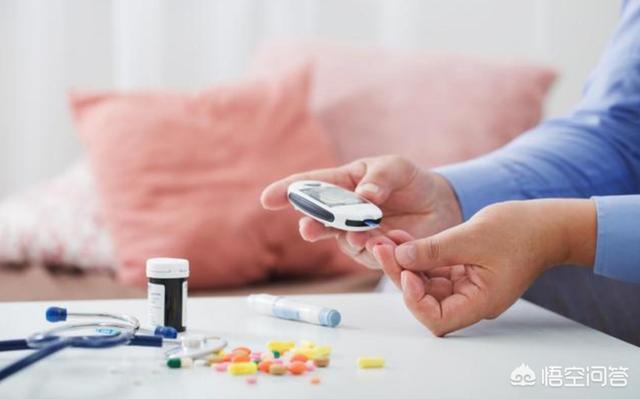
As for elderly patients with diabetes, if the duration of the disease is less than 10 years and the pancreatic function still exists, the level of glycemic control should likewise be as stringent as possible, and it is recommended that at least the fasting blood glucose should be controlled to 4.4-7.0, while the 2-hour postprandial blood glucose should be controlled to less than 10.0, and the glycosylated hemoglobin level should be controlled to less than 7%, which is also the glucose level that can ensure the maximum health benefit and should be noted maintained and controlled.
For some elderly diabetic patients, self-management can be poor, there is a risk of hypoglycemia, the application of insulin agonist or injection of insulin-based cases, you can consider appropriate relaxation of glycemic control goals, in this case, if you can report fasting blood glucose control to less than 7.5, postprandial blood glucose control to less than 11.1 hours of the level of glycated hemoglobin is generally in the level of 7-8%, so that the situation can be considered the "normal range" in this case. In this case, it can be regarded as the "normal range" in this case.
For some more serious cases, such as recurrent infections, repeated serious hypoglycemia, acute cardiovascular disease attacks, acute hospitalization of some elderly diabetic patients, which can further relax the level of blood glucose control, generally speaking, fasting blood glucose 8.5 or less, postprandial blood glucose control to 13.9 or less, glycated hemoglobin control to 8.5% or less, this situation, in the In this case, in the case of difficulty in controlling blood glucose, appropriate relaxation of the "normal range" standard, but also try to control the blood glucose level, only good control of blood glucose level, can better improve the quality of life of the patient, and more conducive to the patient's health benefits.
In short, the so-called "normal range" of blood glucose has different requirements and different values for different situations, but in general, the original is to keep the blood glucose within a certain range, try to control the blood glucose level as much as possible, so that the body's health can obtain greater benefits, and to ensure overall physical health.
We refer to the concentration of glucose in the blood, as blood sugar. Glucose is an important component of the human body and the main source of energy, providing power for the normal functioning of various tissues and organs. Must blood sugar be controlled within the normal range? The answer is yes, because too low or too high blood glucose can have adverse effects on the human body.However, the definition of the "normal range" of blood glucose is not uniform and varies from person to person.Below, Pharmacist Wang will explain the dangers of hypoglycemia and hyperglycemia, as well as the normal range of blood sugar.
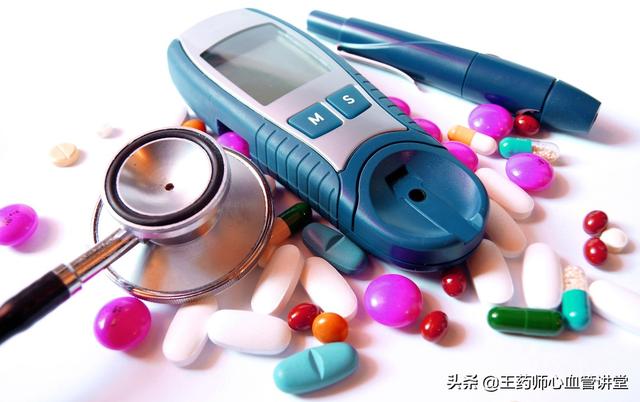
The dangers of hypoglycemia
The diagnostic criteria for hypoglycemia vary from one population to another.The Chinese Guidelines for the Prevention and Control of Type 2 Diabetes Mellitus recommend that the diagnostic criteria for hypoglycemia in non-diabetic patients is blood glucose <2.8 mmol/L. For medicated diabetic patients, as long as the blood glucose is ≤3.9 mmol/L, it is considered as hypoglycemia.
Symptoms of hypoglycemia mainly include hunger, sweating, panic, trembling, palpitations, pallor, trembling of limbs, nausea, vomiting, irritability, etc. In severe cases, there may also be inattentiveness, dizziness, blurred consciousness, cognitive impairment, difficulty in verbal expression or even convulsions and coma.
Prolonged hypoglycemia not only reduces the patient's quality of life, but also causes different degrees of damage to the brain, heart, and other vital organs, leading to brain dysfunction, nerve cell damage and death, and damage to the central nervous system, as well as leading to cardiovascular and cerebral vascular events (arrhythmias, heart attacks, strokes, etc.), and increasing the mortality rate of cardiovascular and cerebral vascular diseases.

The Dangers of High Blood Sugar
When blood glucose is higher than the normal range, it is called hyperglycemia, and together with hypertension and hyperlipidemia, it is called the "three highs".Hyperglycemia is diagnosed when the fasting blood glucose value is 6.1 mmol/L or more and the two-hour postprandial blood value is 7.8 mmol/L or more.
There are many symptoms of hyperglycemia, and the specific performance varies from person to person, mainly including polydipsia, polyuria, polyphagia, emaciation, etc. With the prolongation of the course of the disease, the number of symptoms increases and the harm is aggravated, and there can be: fundopathy, manifested by blurred vision, vision loss, visual field loss and even insomnia; cardiovascular lesions, manifested by palpitations, chest tightness, sweating, etc.; cerebrovascular lesions, manifested by dizziness, headache, etc.; renal lesions, manifested by proteinuria, edema, polyuria, elevated blood pressure, etc.; neuropathy, manifested as numbness of the limbs, sensory impairment and even diabetic foot, etc.
Normal range of blood glucose
Glucose control goals vary for different groups of people.
1、Healthy people: fasting blood glucose 3.9-6.1mmol/L, 2-hour postprandial blood glucose 4.4-7.8mmol/L;
2. Type 1 diabetes mellitus aged 0-18 years: fasting blood glucose 3.9-5.6 mmol/L, bedtime and nighttime blood glucose 4.5-7.0 mmol/L;
3. Type 2 diabetes mellitus aged 0 to 18 years: fasting blood glucose <7.0 mmol/L, glycated hemoglobin controlled below 6.5% as far as possible;
4. Adult type 1 diabetes mellitus: fasting blood glucose 3.9-7.2 mmol/L, 2-hour postprandial blood glucose 5.0-10.0 mmol/L;
5. Adult type 2 diabetes mellitus: fasting blood glucose 4.4-7.0 mmol/L, 2-hour postprandial blood glucose < 10.0 mmol/L;
6. Elderly diabetes mellitus with complications or comorbidities: fasting blood glucose 5.0-8.3 mmol/L; bedtime blood glucose 5.6-10.0 mmol/L;
7. Elderly diabetes mellitus without any complications and comorbidities: fasting blood glucose 5.0-7.2 mmol/L, bedtime blood glucose 5.0-8.3 mmol/L;
8. Gestational diabetes mellitus: fasting blood glucose ≤ 5.3mmol/L, 2 hours after meal blood glucose ≤ 6.7mmol/L.

In conclusion, the normal range of blood glucose is not one-size-fits-all. For healthy people, young diabetics, and diabetics with a short course of the disease, the blood glucose standard should be stricter; for diabetics with a long course of the disease, elderly diabetics, and diabetics with complications or comorbidities, the blood glucose standard can be slightly more relaxed.Regardless of which category you fall into, it is best to keep your blood sugar within the normal range to prevent damage from hypoglycemia or hyperglycemia.
I am Pharmacist Wang, dedicated to helping you manage your body by explaining complex and difficult disease knowledge in plain words. Your praise is my greatest motivation! In addition, if your family members also have related troubles, please forward this article to them!
Keeping your blood sugar in the normal range has a positive, important role in keeping you healthy!
Below the normal range, it is easy to produce hypoglycemia, which is usually manifested as sweating, hunger, panic, trembling, pallor, etc. In severe cases, mental inattention, agitation, irritability and even coma can also occur.
Above the normal range, it is hyperglycemia - what we often refer to as diabetes mellitus, which is caused by insufficient insulin secretion and/or action, and is accompanied by disorders of fat and protein metabolism, and is often combined with high blood pressure, high blood cholesterol, high blood viscosity, and other problems.
However, long-term hyperglycemia will cause lesions in various tissues and organs of the whole body, leading to acute and chronic complications. Such as water loss, electrolyte disorders, nutritional deficiencies, decreased resistance, impaired renal function, neuropathy, fundopathy, cardiovascular and cerebral vascular disease, diabetic foot and so on.
The key issue is that because diabetes is an insidious chronic disease, most patients do not realize they have diabetes, and some patients are found to have blood sugar in the high teens, or even over 20, as well as very high blood lipids, even 70+, which is very dangerous.
Recent studies have shown that some people with diabetes have preexisting manifestations of abnormal fat metabolism.As subcutaneous fat continues to increase and fat moves to internal organs such as the liver, all over the pancreas, it causes a lack of insulin secretion, which can lead to the development of type 2 diabetes.
Therefore, it is recommended that we usually check, more fasting blood glucose, two hours after meals, blood glucose and lipid indicators, found abnormalities should be treated as soon as possible, this metabolic chronic diseases of Chinese medicine treatment is very effective, do not need long-term continuous medication.
Meanwhile, in your daily life, maintain a healthy diet and reasonable exercise to keep a virtuous and healthy habit.
For diabetics, especially those with type 2 diabetes, it is important to treat them aggressively, starting with keeping their blood sugar in the normal range and not allowing their bodies to be damaged by high glucose toxicity, as well as maintaining a healthy diet and sensible exercise.
The most important thing is that type 2 diabetes can be reversed through TCM treatment, thus getting rid of drug dependence!
One last reminder:
Patients with dyslipidemia and type 2 diabetes mellitus, the earlier they are detected, the earlier they are treated, and the more effective the TCM treatment is!
Prevent diabetes, start with Chinese medicine for hyperlipidemia!
Sugar control for all but some older sugar users is best done by keeping your blood sugar within the normal range. Why?
First, the better the blood sugar control, the later the complications will come
(1) The reason why sugar lovers demand sugar control is to prevent and control complications.If the blood sugar is kept within the normal range, then diabetes is not harmful to the organism. However, this is only an ideal state.Because, no sugar addict can guarantee that their blood sugar will stay off the charts all the time.
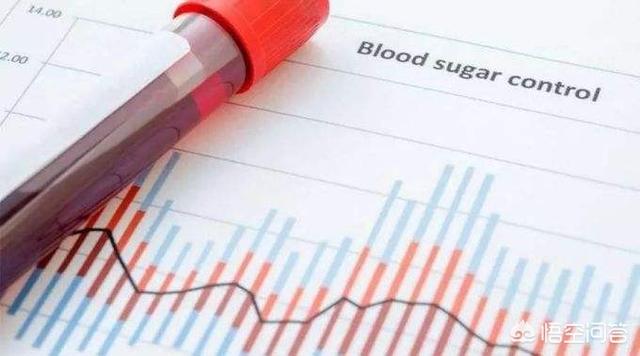
② In real life, many sugar users often have blood glucose too high or too low, and some even directly lead to the emergence of acute complications. Previously, I have introduced many times, when the blood glucose level, more than 33.3mmol / L, it is easy to complicate diabetic ketoacidosis and diabetic hypertonicity.
③Even if it does not reach 33.3mmol/L, but just fasting often exceeds 7.0mmol/L; postprandial blood glucose often exceeds 10.0mmol/L, although there will be no immediate complications, this high blood glucose state will lead to lesions in the endothelial cells of the blood vessels, resulting in blood vessels that are hardened and easy to be clogged, which will lead to the emergence of a variety of diabetes mellitus chronic complications, such as diabetic nephropathy, diabetic ophthalmopathy, diabetic foot, etc.
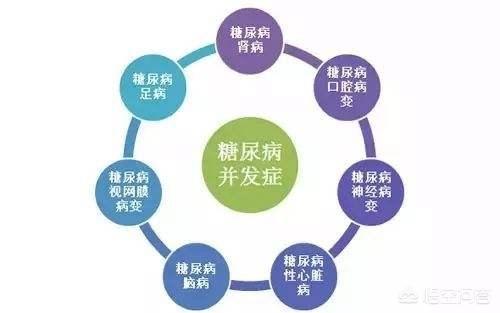
④ If we, sugar lovers, live in a way that keeps our blood sugar as close as possible to the normal range.Glycosylated hemoglobin less than 7, fasting blood glucose less than 7.0 mmol/L, and postprandial blood glucose less than 10.0 mmol/L are effective in delaying the onset of complications.
Second, the elderly sugar lovers sugar control requirements are not so high
Elderly glycosurgeons are unique in that they are older, have a limited life expectancy, and are often comorbid with a number of other diseases. Also, they are not sensitive to hypoglycemia.
If you are too strict on sugar control, it often leads to hypoglycemia, and sugar control does not bring much benefit. Therefore, the sugar control requirements for elderly sugar users are, relatively speaking, much more lenient. The details are shown in the figure below:
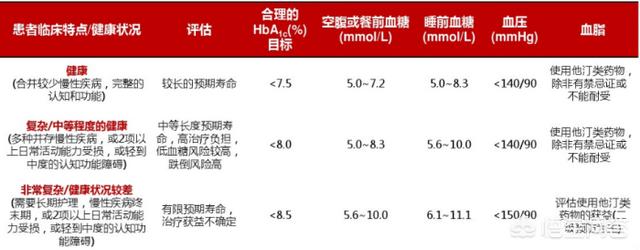
In general, only elderly sugar users, blood sugar is not required to be in the normal range; other sugar users, it is best to keep their blood sugar in the normal range.
It's not easy to create, so if you find it helpful, please like, retweet, or comment! If you still don't understand, please leave a message in the comment section!
[Professional doctor to answer your questions
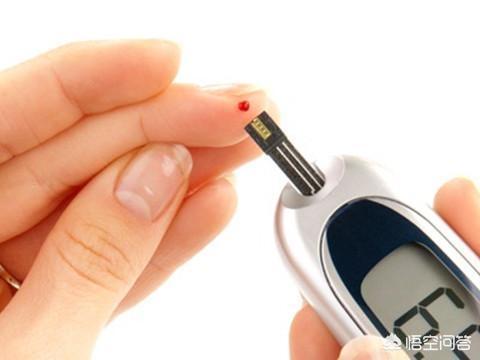
For diabetics, there is no issue of greater concern than how to bring down blood sugar, and how much blood sugar can be lowered to the appropriate, but also a matter of anxiety, looking at the often up and down changes in blood glucose, always more or less on their own sugar reduction effect has to worry about. In fact, this mood is understandable, but there is really no need to worry too much about a few numbers, how to understand?
First, find out how blood sugar is managed in the Chinese Guidelines for Diabetes Prevention and Control:
Normal blood glucose: fasting blood glucose 3.9-6.1mmol/L and 2-hour postprandial blood glucose 4.4-7.8mmol/L.
Pre-diabetes: fasting blood glucose 6.1-7.0 mmol/L or 2-hour postprandial blood glucose 7.8-11.1 mmol/L
Diabetes mellitus: fasting blood glucose greater than 7.0 mmol/L or 2-hour postprandial blood glucose greater than 11.1 mmol/L
It can be seen from this, diabetic patients to control blood glucose below the diagnostic standard of diabetes mellitus is the most basic requirement, and can be reduced to the normal blood glucose range that is the most ideal result, in the "at least" and "the most ideal" there is a range between, which gives the effect of blood glucose control can provide floating space, means that different people in the control effect can be different, and this is exactly the case. There is a range between "at least" and "optimal", which gives the blood glucose control results room to fluctuate, meaning that different people can have different control results, and this is exactly what happens.

Secondly, to understand, what is the danger of high blood sugar? The various complications of diabetes are not caused by the infection of bacteria and viruses, but by the long-term high blood sugar damage to the endothelium of blood vessels, a large number of fat deposits on it, causing inflammatory reactions, leading to atherosclerosis and plaque formation, and ultimately causing the heart, brain, eyes, kidneys, and other organs of the whole body due to lesions. Therefore, for diabetics, it is important to control blood sugar, but also to control blood lipids, blood pressure, etc., in order to effectively prevent and delay the occurrence of complications.
Among them, the control of LDL in blood lipids is especially important, it is the most direct factor causing vascular lesions after endothelial damage, if it can be controlled at a lower level, even if the endothelium is damaged, the degree of lesions will be greatly reduced; clinically, the control of LDL in diabetic patients is very strict, and it is required that it be controlled at least at 2.6 mmol/L or less, less than 1.8 mmol/L is the ideal target, especially for patients with a long course of diabetes, which is more important than the control of blood glucose. LDL control in diabetic patients is very strict, requiring control of at least 2.6 mmol/L or less, less than 1.8 mmol/L is the most desirable goal, especially for patients with a longer course of diabetes, which is more important than controlling blood glucose. Therefore, on the basis of strict control of low-density lipoprotein, diabetic patients, especially the elderly will fasting blood glucose control at about 7.0 mmol / L, 2 hours after the meal blood glucose control at 10.mmol / L is completely acceptable, not necessarily to control to normal values.

Then there is with the prolongation of diabetes disease, vascular lesions more or less will occur, with lesions of blood vessels to high blood pressure tolerance decreases, not only will further aggravate the vascular lesions, but also may make plaque and vascular rupture caused by serious consequences. Therefore, for the longer course of the disease and elderly patients, it is quite important to control the blood pressure below 130/80mmol/L. The benefit to the patient is more important than the pursuit of lowering blood glucose to the normal value, and it is not impossible to have the fasting blood glucose less than 7.0mmol/L and the 2 hours postprandial blood glucose less than 10.mmol/L.
In summary, the treatment of diabetes should be multifaceted, not just lowering blood glucose, how much blood glucose should be lowered should be combined with the condition, age, complications and other indicators of the control of the requirements, briefly summarized as follows:
Young and middle-aged diabetic patients strive to keep their blood glucose at normal levels, provided that their LDL and blood pressure are controlled to meet the above requirements;
Longer-term and elderly diabetic patients, on the basis of fasting blood glucose less than 7.0 mmol / L, 2 hours after meal blood glucose less than 10.mmol / L, the focus should be on whether the low-density lipoprotein and blood pressure can be controlled to meet the standard.
I hope this answer can help you, welcome to click on the attention and leave a message, together to learn and exchange more health knowledge.
Diabetes is the number one metabolic disease in China. Patients with a clear diagnosis of diabetes should be guided by a specialist to develop a reasonable glucose-lowering program to control their blood glucose in the target range and reduce damage to target organs. So, is it necessary to control blood glucose in the normal range? Next, Medical Senlution will analyze it for you.
Physiologically, blood glucose regulation is strongly influenced by tissue sensitivity to insulin and insulin secretion function, and elevated blood glucose occurs when insulin resistance or reduced insulin secretion has occurred. Significant elevation of blood glucose will increase the damage to blood vessels, heart, kidney, retina, nerves and other organs. The greater the magnitude of blood glucose elevation, the greater the fluctuation, and the longer the duration of the disease, the more serious the damage to the target organs. Lowering blood glucose can delay the emergence of chronic complications such as cardiovascular disease, kidney disease, and more importantly, reduce the risk of end-stage mortality while reducing damage to target organs. However, it is not always necessary to control blood glucose in the normal range. Although controlling blood glucose in the normal range can further reduce the damage to target organs, comprehensive consideration should be given to the patient's tolerance and whether hypoglycemia will occur.
Therefore, blood glucose control varies from person to person. Patients who are young, have a short disease duration, no serious complications, and no hypoglycemia, can control their blood glucose in the normal range if they can tolerate it, aiming to minimize the damage to target organs and prevent complications; for most diabetic patients, the level of glycemic control will be slightly higher than the normal range, and usually fasting blood glucose will be controlled below 7.0 mmol/L, and postprandial blood glucose will be controlled below 10 mmol/L, which can prevent hypoglycemia while minimizing the damage to target organs; however, for those who are elderly, have a long disease duration, and have multiple complications, glycemic control varies. For most diabetic patients, the level of blood glucose control will be slightly higher than normal, usually the fasting blood glucose control is below 7.0mmol/L, and the 2-hour postprandial blood glucose control is below 10mmol/L, which can prevent the occurrence of hypoglycemia while reducing the damage to the target organs; however, for the patients with advanced age, long duration of disease, multiple complications, and prone to hypoglycemia, the glycemic control guideline can be appropriately relaxed in the second case in order to reduce the difficulty in the care of family members, and prevent the risk of falls due to hypoglycemia, the details of which will vary according to the individual.
In summary, diabetic patients are not required to control their blood glucose in the normal range; patients who are young, have a short course of disease, no serious complications, and no hypoglycemia can control their blood glucose in the normal range; most diabetic patients usually control their fasting blood glucose below 7.0 mmol/L, and control their postprandial blood glucose 2 hours after meal below 10 mmol/L; patients who are old, have a long course of disease, have multiple complications, and prone to hypoglycemia can appropriately relax the blood glucose control pointers, depending on the individual. For patients with advanced age, long duration of illness, multiple complications, and susceptibility to hypoglycemia, the glycemic control guideline can be appropriately relaxed, depending on the individual.
Thank you all for reading!
We are looking forward to your attention and presenting more health knowledge to you!
Note: The images in this article come from the Internet, if infringement of copyright, please contact to remove. The content of the article is only as a health science popularization, not as a medical advice or opinion, and does not have the condition of medical guidance.
Not necessarily.
It is not necessary to keep either blood glucose or blood pressure within normal ranges; it is sufficient to keep blood glucose and blood pressure within reasonable limits.

Diabetes mellitus and hypertension are not scary in themselves, but what is scary is that diabetes mellitus and hypertension lead to acute and chronic complications, which can all lead to cardiovascular and cerebrovascular accidents. These complications of diabetes and hypertension can lead to a serious decline in the quality of life of some patients, some patients can be disabled due to these complications, and some patients will regretfully pass away because of these complications, which is known as either death or disability.
The dangers of high or low blood glucose are very serious, so the blood glucose of diabetes should be individualized according to the presence of diabetic complications (such as hypertension, nephropathy, coronary artery disease, encephalopathy, and retinopathy), the presence of recurrent hypoglycemia, how long has the diabetes, and the age of the patient with diabetes to develop individualized ranges of glycemic control.
Normally, the normal range of blood glucose is 3.9 to 6.1 mmol/L .
The approximate clinical glycemic control of diabetes is as follows:
1, not eating is also known as fasting when blood glucose control goals:
Ideal fasting blood glucose target range: 4.4 to 6.1 mmol/L .
Acceptable fasting glucose goal <7.0 mmol/L.
Fasting glucose control is poor if the blood glucose level is >7 mmol/L.
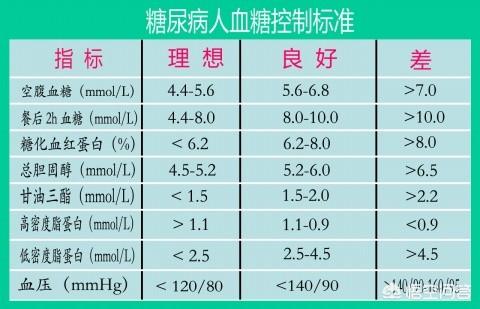
2. Postprandial blood glucose control ranges are as follows:
Ideal postprandial goal: 4.4 to 8 mmol/L.
Acceptable postprandial glucose goal <10 mmol/L .
Postprandial glucose >10 mmol/L indicates poor glycemic control.
3. The range of glycemic control for critically ill patients has its own special requirements:
The general target range is 8-10 mmol/L.
(Images from the Internet, not for commercial use! (The content of this article is for reference only, not as a basis for diagnosis and medication, and can not replace the diagnosis and treatment of doctors and other medical personnel and advice, if you are not feeling well, please seek medical attention in a timely manner.)
As the saying goes, you don't drink from a strong pressure faucet.
Everything has its regularity, there is a degree. If you do something rashly and break its laws, you will be punished twice as much.
Many sugar lovers (including myself) have done this kind of stupid thing, the pursuit of standards, mandatory forcing their own blood sugar and normal healthy people close to the standard ...... even at the expense of eating less, not eat food, would rather take a few more drugs to increase the dose of insulin .......
Of course, our supervising doctor has a part to play here!
I am now looking at the way and method of treating diabetes in hospitals in a different light.
Self-regulation, blood sugar not moving closer to the absolute standard, control in the middle of the upper and lower standards (your glycemic index is the same as a normal person, are you still called a diabetic?). . Then use food to adjust, slightly higher idea to work on eating time, cooking methods, ingredient selection, always find a way! It eliminates the worry of low blood sugar because you don't use medication.
I have more than ten years of experience and practice, the life of the sugar man is still mainly in their own hands. If the hospital can cure it? No comment. Currently diabetes in the whole world is a head of two big problems, the doctor in addition to prescribing drugs for you to lower sugar, add drugs to lower sugar ...... there are other ways? And who all know is medicine three poisons, press down the gourd up the ladybird, the bad luck of the end is the patient ......
And live and explore.
This article is purely personal and is not meant to defame anyone!
Modern medicine has made a lot of progress compared to what it was before, and even if those Western medical hacks don't recognize it, they can't deny the progress and development of modern medicine. In the early days of the country, the rate of disease and death was relatively high, and it was not easy for an ordinary family to raise their children to adulthood.

Although medicine has advanced a lot, it still cannot cure some chronic diseases, such as diabetes. In a way, diabetes can be called an immortal cancer. In order to give you a better understanding of this disease, let me share some knowledge about it.
1. Diabetes is divided into 2 main categories:
Based on pathogenesis, diabetes mellitus can be categorized into 2 main groups, namely absolute deficiency of insulin secretion and insulin resistance cum insufficient secretion.
The most common clinical condition is type II diabetes mellitus, which is mainly characterized by a mid-life onset and early onset of insulin deficiency, but rather manifests itself as insulin resistance, which means that the insulin receptor is no longer sensitive to insulin.
In addition to this, there are specific types of diabetes that cannot be classified in Type I and Type II. This is because the cells that secrete insulin are the pancreatic beta cells, and anytime there is an abnormality in this cell, it can cause an increase in blood sugar. There are many reasons that can cause problems with pancreatic beta cells, such as congenital problems with the genes for beta cell function, and increased destruction of pancreatic islet cells due to immune factors. There are also certain medications, infections, etc. that can cause elevated blood sugar.
2. Do diabetic patients need to keep their blood sugar within normal limits?
In the mind of a diabetic patient, there is a desire to keep their blood sugar on the low side, not realizing that there are some risks associated with this. In a way, the nature of diabetes is that the body's ability to regulate blood sugar decreases, which means that blood sugar is not only prone to be high, but also to be low.
For diabetic patients, short-term elevation of blood glucose is not harmful, but if hypoglycemia occurs it is fatal, because many of the body's vital organs need glucose for energy, and when hypoglycemia occurs, it is impossible to ensure the blood supply to such vital organs.
So for diabetic patients, blood glucose control in the normal range is not good, because it is easy to hypoglycemia, in the clinical are recommended to control blood glucose on the high side.
Normal people's fasting blood glucose in 3.9 ~ 6.1mmol / L, postprandial blood glucose value dry <7.8mmol / L. For diabetic patients, fasting blood glucose control target can be relaxed a little bit, in the 4.4 ~ 7mmol / L can be, and postprandial 2 hours of blood glucose in the 10mmol / L or less can be.

The requirement of controlling blood sugar for diabetic patients is actually mainly to reduce the incidence of complications. Complications of diabetes are categorized into acute and chronic ones, and these chronic complications are like boiling a frog in warm water; many people do not see the danger of diabetes, and when one day there are chronic complications, there is nothing more that can be done.
Purely hand-typed, it is not easy, if you feel that the writing can also be rewarded a praise, point a concern, if you have any questions can be left below ......
This question and answer are from the site users, does not represent the position of the site, such as infringement, please contact the administrator to delete.